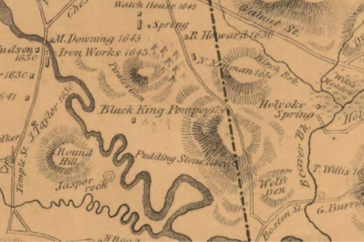
Mike Alvarez, postdoctoral diversity and innovation scholar in communication.
When Anthony Bourdain, celebrity chef, author and TV personality, took his own life in 2018, it was shocking to many. How can a highly creative and successful person commit suicide? In his programs, he took his viewers around the world with such joie de vivre, as if he were hungry for life itself.
This seeming paradox — that creative people who embrace life to its fullest can commit the ultimate anti-creative act — is the subject of Mike Alvarez’s first book.
In “The Paradox of Creativity: Authentications of Human Existence,” Alvarez, a new postdoctoral diversity and innovation scholar in communication, conducts case studies of 11 highly creative people from different fields, generations, countries and cultures who ended their own lives, including Iris Chang, Phyllis Hyman, Kurt Cobain, Alan Turing and Robin Williams.
Using phenomenology and psychobiographical methodology, Alvarez examines traumatic episodes in his subjects’ lives, researching their creative output as well as primary and secondary sources to theorize how both creativity and suicide were the means by which these individuals wrestled with adverse life experiences.
Alvarez is no stranger to adversity. He both witnessed and suffered from domestic violence as a child and developed depression, anxiety and persecutory delusions as a teenager. In his undergraduate years at Rutgers, his mental health worsened, culminating in a suicide attempt. He writes about his experiences in his forthcoming memoir, “The Color of Dusk.” (Among his degrees, Alvarez holds an M.F.A. in creative writing from Goddard.)
Studying psychology at Rutgers, coupled with his own struggles, Alvarez became disillusioned about the mental health disciplines, which he found more concerned with symptoms and diagnoses than with causes rooted in the life stories of those who suffer.
Today, he says, there is mounting evidence that adverse experiences can produce symptoms, sometimes years later, that we associate with mental illness such as major depression, paranoia or bipolar disorder — illnesses that are thought to originate in chemical or gene dysfunction.
“My criticism is directed at the almost reflexive response by mental health institutions and their myriad actors to diagnose, medicate and institutionalize, without trying to get at what’s really ailing the person, from that person’s point-of-view. Shoot first, ask questions later. I experienced this firsthand in psychiatric consultations that lasted as little as ten minutes, and inside a mental hospital, where a person’s backstory bore little to no relevance,” says Alvarez.
These backstories became the subject of his senior thesis at Rutgers and the basis of his current book.
His central thesis is that individuals who experience traumas — such as the death of a parent, divorce or abuse — can find relief and even healing through creativity. But if that creative outlet dries up or is cut off and another can’t be found, a person may see suicide as the ultimate way to assert agency — to take control and finally resolve the original wound.
For a life that feels hopeless, that act of agency can be, paradoxically, affirming. The suicidal act may be a way to atone for or right a perceived wrong (such as “I don’t deserve to live”). It could be an attempt to make life better for the loved ones left behind or to memorialize a loved one long dead. And it could be a combination of factors. Whatever the reasons, suicide can be perceived by the actor as a way to say “I exist” in a world where they feel their existence is tenuous.

Kurt Cobain on WFNX in 1991. Photo by Julie Kramer, CC.
Take Kurt Cobain, the lead singer-songwriter for the chart-topping 90s grunge band Nirvana, who committed suicide at 27. Alvarez identifies the divorce of Cobain’s parents when Kurt was only 9 as the childhood trauma that set him on a lifelong journey of physical and emotional pain. Not only was the immediate dissolution of his family devastating, but Cobain subsequently developed troubled relationships with both his father and mother, and left home at age 15. He would spend the next four years as a vagabond, living in 10 different homes.
In addition to songwriting, Cobain was an incessant visual artist and diarist and, in all his creative outlets, the loss of home finds form. His artwork depicts a fascination, often violent, with wombs, birth, babies and parents, and his lyrics tell a similar story, as in this line: “They come with a flash of light/ And take my family away.”
Despite being fatalistic about his own entry into adulthood and family, he found hope in his marriage to Courtney Love and in the birth of their daughter, Frances, who made him feel resurgently alive. At the same time, he was terrified of losing them both, “the threat of the original loss being replicated,” says Alvarez. So, when the couple’s drug use led to temporarily losing custody of Frances, Cobain became suicidal. It would be another two years of struggle and what he felt was uninspired creativity before he took his own life, saying in his suicide note that his daughter would be better off without him and that he was undeserving of his wife. Alvarez contends that Cobain’s suicide authenticated his truth: he had already psychically died in childhood.
“Studies have found that among all persons, creative people actually exhibit better mental health than noncreative people. Among creative persons, however, those who are intensely creative tend to suffer greatly.”
In addition to the 11 case studies in “The Paradox of Suicide and Creativity,” Alvarez provides intervening chapters on the state of the literature, developing theories about creativity and suicide and their interplay. He gives context that answers such questions as: do creative people commit suicide at higher rates than non-creative people?
“Studies have found that among all persons, creative people actually exhibit better mental health than noncreative people. Among creative persons, however, those who are intensely creative tend to suffer greatly,” says Alvarez.
Many books have been written about the link between creativity (or genius) and madness, and sometimes these books take up the connection between creativity and suicide, but a book exclusively about creativity and suicide is rare, says Alvarez. He thinks this may have to do with the stigma of suicide.
“The thought that suicide is a possibility that could await anyone — a door through which anyone could walk — is terrifying. Scholars either steer clear of suicide, or when they do approach it, they study it at a remove, the distance achieved via quantification and/or diagnosis,” he says.
As a communication scholar, Alvarez will continue to examine the subject of suicide. A planned project will explore how suicidal people use online platforms such as suicide prevention apps and virtual worlds to create meaning and community.
In the meantime, Alvarez is responding to current events as the lead author of a co-authored book, “A Plague for Our Time: Dying and Death in the Age of Covid-19,” under contract with McFarland. The book examines narratives about end of life during the pandemic.
The 24-hour National Suicide Prevention Lifeline is 800-273-8255. UNH Psychological and Counseling Services provides 24-hour emergency services at (603) 862-2090 (Relay NH: 1-800-735-2964).
-
Written By:
Susan Dumais '88 '02G | College of Liberal Arts


















































